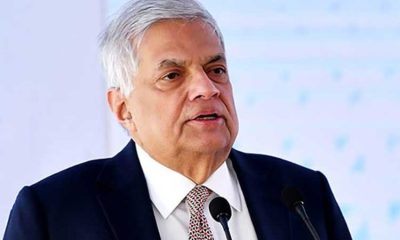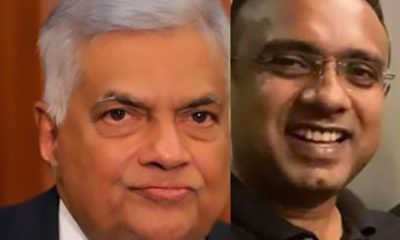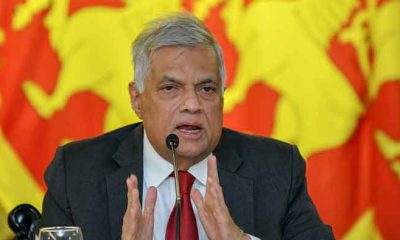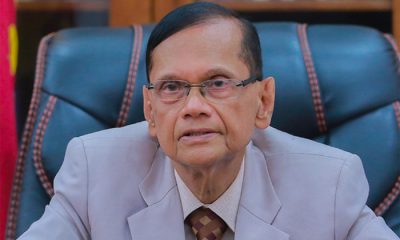Features
Israel & the US, Modi’s heatwave, and Ranil as Common Government Candidate
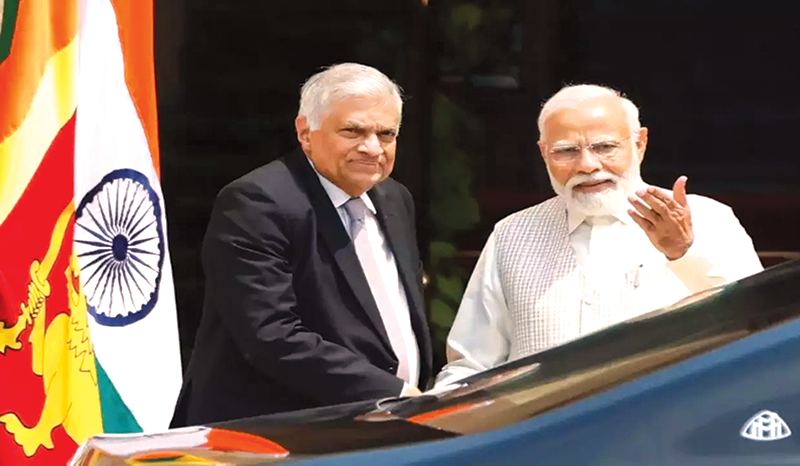
by Rajan Philips
To continue from where I left last week, the Middle East standoff between Iran and Israel has ended without further escalation. An “audible sigh of relief,” as BBC headlined it, swept through the region, and more so perhaps in Washington. Israel did have the last word by striking measuredly at Iran’s military installations in two Iranian cities and in south Syria. Iran ignored the strikes as inconsequential and “a defeat for the enemy.”
Lost in the attention to regional tension was the US vetoing of the UN Security Council resolution proposed by Algeria to grant Palestine full-member status at the UN, moving up from the permanent observer status it has had since 2012. The US diplomatic excuse was that a full membership status to Palestine should not be given through the UN process, but through “direct negotiations between the parties.” This reasoning is transparently illogical and also impractical given Mr. Netanyahu’s flat refusal of the two-state solution.
At the same time, the Biden Administration is trying to restrict Israeli military operations in Gaza and increase flow of aid and assistance to beleaguered Gazans now on the verge of famine. In addition, the Administration is also imposing sanctions against fundraisers for expanding Jewish settlements on the West Bank, and against Israeli military and police units for human violations of Palestinians in the settler areas. But that is not enough to stop Israeli forces from going ahead with ground assault in Rafah after two days of aerial pounding.
Washington appears to be taking a two-pronged approach to the crisis: provide diplomatic and political cover for Israel in international fora, and pushing for restraint on the military operations of the Netanyahu government. Perhaps a necessary approach not only to be effective in the Middle East but also to weather the political storms in the US. The latter is becoming the bigger political worry for Biden. America’s great universities are divided down the middle over the Israeli-Palestinian crisis. Republicans in the Congress are fomenting the fires in the name of fighting alleged antisemitism on campuses, even though a number of them are notoriously known for antisemitism in their politics.
On Wednesday, Republican House Speaker Mike Johnson travelled to New York to address a group of Jewish students on the steps of Columbia University library amidst heckling by pro-Palestinian protesters that included Muslims, Jews and other Americans. His mission: to call for the resignation of Columbia University President Minouche Shafik, an impeccably qualified Egyptian American woman. Democratic Congresswoman Ilhan Omar, a Somali American from Minnesota, joined the protesters at Columbia University, where her daughter is among the arrested demonstrators. In an official event in Syracuse protesters greeted President Biden with placards calling him “Genocide Joe”.
And on Thursday, the political and legal chaos surrounding Donald Trump reached a crescendo with simultaneous court proceedings in New York and at the Supreme Court in Washington. The apex court heard oral arguments on whether Trump is entitled to absolute presidential immunity, and peppered the lawyers for Trump and the government with penetrating questions. Judges in all lower courts have all decreed the obvious that there is no such immunity. The Supreme Court is expected to reject the claim of absolute immunity but its conservative majority could send the matter back to the lower courts to determine the facts in the case to which immunity would or would not apply. That would delay the trial and that is all that Trump is looking for now – in the hope that all his legal troubles could be ‘disappeared’ by winning the November election and allowing himself to a sweeping self-pardon dispensation.
Modi, Muslims and Maldives
The Indian election for the 18th Lok Sabha is now into its second week and second phase. Phase 1 voting was completed on Friday, April 19 in 102 Lok Sabha seats which included all 39 seats in Tamil Nadu. Phase 2 voting was on Friday this week covering 88 constituencies in 13 states. All of Kerala’s 20 seats are in Phase 2, which also includes voting for a portion of the seats in larger states like Bihar, Karnataka, Maharashtra, Madhya Pradesh, Rajasthan, Uttar Pradesh and West Bengal. Severe heatwave conditions are impacting voter turnouts in a number of states. But the biggest political heatwave was caused by Prime Minister Modi in an election campaign speech in Rajasthan.
Two days into the elections last Sunday, the Prime Minister threw away his usual dog whistle targeting Muslims and blew full into his foghorn of demagoguery – characterizing the commitment in the Congress Party manifesto to address wealth and income inequalities in society as a scheme to redistribute among Muslims the property and wealth of others. He even accused that Prime Minister Manmohan Singh had already started the scheme in 2006 and made Muslims the first claimants to the country’s resources. Then the punch line, as quoted in The Hindu: “That means the property will be distributed among those who have a large number of children… and among the intruders. Is it acceptable to you?”
Anyone other than Modi and his saffron followers would see the Congress manifesto as a response to increasing inequality during the last 10 years in spite of India’s overall economic growth. In 2006, the cerebral Manmohan Singh was addressing the structural problem of inequality and the purpose of public policy to uplift the impoverished – the subaltern castes, women and minorities including Muslims. But facts do not matter to Modi when it comes to Muslim bashing and he will do that not only during elections but any time between them as well. The hatred for Muslims might be part of Mr. Modi’s political DNA given his deep roots in the Rashtriya Swayamsevak Sangh (RSS), the onetime collaborator with colonial rule and the later progenitor of all right wing, anti-Muslim, and anti-Congress political formations in India.
The RSS will mark its birth centenary on September 27, 2025. Fittingly, the Sangh’s most accomplished son will be there as Prime Minister to preside over the occasion. Just as he was there to preside at the inauguration of the Ram Mandir in Ayodhya, Uttar Pradesh. But how fitting is it for India, the world’s largest democracy on course to become its third largest economy, to have a Prime Minister spewing hatred of Muslims when India is also the country with the worlds third largest Muslim population? Though unconnected, it was still fitting in a different way that days after Modi’s Muslim-hate speech in Rajasthan, the voters in Maldives voted resoundingly for the People’s National Congress (PNC) party of President Mohammad Muizzu who is known to be keen on steering Maldives away from India and closer to China. The PNC won 70 of 93 members in the national parliament, while the former ruling party, Maldivian Democratic Party (MDP), dubbed the ‘pro-India’ party, won just 12 seats.
Modi is not the most favourite Indian person in Maldives especially after his January visit to the beaches of the Indian islands of Lakshadweep, the oceanic neighbour of Maldives. His social media posts promoting Lakshadweep tourism were seen by Maldivians as crass and insensitive to the importance of tourism for the Maldivian economy. Although Modi’s hate speech was not a factor in the Maldivian election, it did not escape from being duly noted by Maldives politicians.
Politically, Modi balances his anti-Muslim diatribes with his Hindutva embrace of the multiple linguistic states and regions of India. To wit, his bottom-trawling efforts for votes in Tamil Nadu by resurrecting the controversy over Katchatheevu. In Kerala, however, where both Muslims and Christians are historically strong communities, the BJP is trying to set up the Christians against the Muslims. But the BJP is still the guest actor in Kerala where the battle is between the two front alliances led by the Congress and the Communist Party (CPM), even though outside Kerala the Congress and the CPM are part of the INDIA alliance. Rahul Gandhi himself is contesting from a seat in Kerala, Wayanad, after leaving Amethi, the family borough in Uttar Pradesh, under BJP pressure.
Ranil and Sunak
Modi’s brief resurrection of the Katchatheevu matter was all about embarrassing the DMK in Tamil Nadu and not at all about creating a row with Sri Lanka. Sri Lanka is now well wrapped up in Indian tentacles, and so it matters little on which side of the maritime boundary that Katchatheevu is located. The latest of them is the Ramayana Trail, the tracking of which was recently sponsored by the Indian High Commission in Colombo. The Sri Lankan search for Ravana’s helicopter may have ended with the exit of Gota, but looking for Ravana’s helicopter along the Ramayana trail could be a real booster to local tourism that apparently now permits the use of Indian Rupee as a designated tourist currency.
India is not the only one interested foreign party in Sri Lanka. The election season is apparently drawing special visitors from China, Japan, the US and the UK. The British election season is also likely to start soon as Prime Minister Rushi Sunak has indicated that the next election (due before January 28, 2025) will be held in 2024. It could come after Sri Lanka’s presidential election in September-October. There are interesting parallels between the situations of Ranil Wickremesinghe in Sri Lanka and Rush Sunak in Great Britain.
Both came into office as caretakers replacing predecessors who were forced to leave office. Both are viewed as good economic managers, although politically Mr. Wickremesinghe is a little too long in the tooth while Mr. Sunak is still a green Tory. Mr. Sunak’s Conservative Party has a good majority in parliament, but he has control over the party – whether in parliament or in the country. A committed Brexiteer, Mr. Sunak has had to bring in as his Foreign Minister, former Prime Minister David Cameron who quit over Brexit. Mr. Cameron definitely brings gravitas to foreign policy but has no national purchase. In short, unless there is a Labour earthquake, Mr. Sunak’s Prime Minister days are numbered.
Ranil Wickremesinghe’s stars and fortunes are different and might be even rising. He has no party in parliament but is in total control of parliament. He has no party to take to the hustings but that gives him the freedom to shop around for an alliance and promote himself as the common government candidate. A new political animal. The UNP-SLPP alliance is all but formalized for the presidential election. But they will keep their rallies separate for May Day. The rallies will be watched for their crowd size as a measure of political support and organizational resources. The election process itself would pick up pace after May Day next week.
Features
The heart-friendly health minister

by Dr Gotabhya Ranasinghe
Senior Consultant Cardiologist
National Hospital Sri Lanka
When we sought a meeting with Hon Dr. Ramesh Pathirana, Minister of Health, he graciously cleared his busy schedule to accommodate us. Renowned for his attentive listening and deep understanding, Minister Pathirana is dedicated to advancing the health sector. His openness and transparency exemplify the qualities of an exemplary politician and minister.
Dr. Palitha Mahipala, the current Health Secretary, demonstrates both commendable enthusiasm and unwavering support. This combination of attributes makes him a highly compatible colleague for the esteemed Minister of Health.
Our discussion centered on a project that has been in the works for the past 30 years, one that no other minister had managed to advance.
Minister Pathirana, however, recognized the project’s significance and its potential to revolutionize care for heart patients.
The project involves the construction of a state-of-the-art facility at the premises of the National Hospital Colombo. The project’s location within the premises of the National Hospital underscores its importance and relevance to the healthcare infrastructure of the nation.
This facility will include a cardiology building and a tertiary care center, equipped with the latest technology to handle and treat all types of heart-related conditions and surgeries.
Securing funding was a major milestone for this initiative. Minister Pathirana successfully obtained approval for a $40 billion loan from the Asian Development Bank. With the funding in place, the foundation stone is scheduled to be laid in September this year, and construction will begin in January 2025.
This project guarantees a consistent and uninterrupted supply of stents and related medications for heart patients. As a result, patients will have timely access to essential medical supplies during their treatment and recovery. By securing these critical resources, the project aims to enhance patient outcomes, minimize treatment delays, and maintain the highest standards of cardiac care.
Upon its fruition, this monumental building will serve as a beacon of hope and healing, symbolizing the unwavering dedication to improving patient outcomes and fostering a healthier society.We anticipate a future marked by significant progress and positive outcomes in Sri Lanka’s cardiovascular treatment landscape within the foreseeable timeframe.
Features
A LOVING TRIBUTE TO JESUIT FR. ALOYSIUS PIERIS ON HIS 90th BIRTHDAY

by Fr. Emmanuel Fernando, OMI
Jesuit Fr. Aloysius Pieris (affectionately called Fr. Aloy) celebrated his 90th birthday on April 9, 2024 and I, as the editor of our Oblate Journal, THE MISSIONARY OBLATE had gone to press by that time. Immediately I decided to publish an article, appreciating the untiring selfless services he continues to offer for inter-Faith dialogue, the renewal of the Catholic Church, his concern for the poor and the suffering Sri Lankan masses and to me, the present writer.
It was in 1988, when I was appointed Director of the Oblate Scholastics at Ampitiya by the then Oblate Provincial Fr. Anselm Silva, that I came to know Fr. Aloy more closely. Knowing well his expertise in matters spiritual, theological, Indological and pastoral, and with the collaborative spirit of my companion-formators, our Oblate Scholastics were sent to Tulana, the Research and Encounter Centre, Kelaniya, of which he is the Founder-Director, for ‘exposure-programmes’ on matters spiritual, biblical, theological and pastoral. Some of these dimensions according to my view and that of my companion-formators, were not available at the National Seminary, Ampitiya.
Ever since that time, our Oblate formators/ accompaniers at the Oblate Scholasticate, Ampitiya , have continued to send our Oblate Scholastics to Tulana Centre for deepening their insights and convictions regarding matters needed to serve the people in today’s context. Fr. Aloy also had tried very enthusiastically with the Oblate team headed by Frs. Oswald Firth and Clement Waidyasekara to begin a Theologate, directed by the Religious Congregations in Sri Lanka, for the contextual formation/ accompaniment of their members. It should very well be a desired goal of the Leaders / Provincials of the Religious Congregations.
Besides being a formator/accompanier at the Oblate Scholasticate, I was entrusted also with the task of editing and publishing our Oblate journal, ‘The Missionary Oblate’. To maintain the quality of the journal I continue to depend on Fr. Aloy for his thought-provoking and stimulating articles on Biblical Spirituality, Biblical Theology and Ecclesiology. I am very grateful to him for his generous assistance. Of late, his writings on renewal of the Church, initiated by Pope St. John XX111 and continued by Pope Francis through the Synodal path, published in our Oblate journal, enable our readers to focus their attention also on the needed renewal in the Catholic Church in Sri Lanka. Fr. Aloy appreciated very much the Synodal path adopted by the Jesuit Pope Francis for the renewal of the Church, rooted very much on prayerful discernment. In my Religious and presbyteral life, Fr.Aloy continues to be my spiritual animator / guide and ongoing formator / acccompanier.
Fr. Aloysius Pieris, BA Hons (Lond), LPh (SHC, India), STL (PFT, Naples), PhD (SLU/VC), ThD (Tilburg), D.Ltt (KU), has been one of the eminent Asian theologians well recognized internationally and one who has lectured and held visiting chairs in many universities both in the West and in the East. Many members of Religious Congregations from Asian countries have benefited from his lectures and guidance in the East Asian Pastoral Institute (EAPI) in Manila, Philippines. He had been a Theologian consulted by the Federation of Asian Bishops’ Conferences for many years. During his professorship at the Gregorian University in Rome, he was called to be a member of a special group of advisers on other religions consulted by Pope Paul VI.
Fr. Aloy is the author of more than 30 books and well over 500 Research Papers. Some of his books and articles have been translated and published in several countries. Among those books, one can find the following: 1) The Genesis of an Asian Theology of Liberation (An Autobiographical Excursus on the Art of Theologising in Asia, 2) An Asian Theology of Liberation, 3) Providential Timeliness of Vatican 11 (a long-overdue halt to a scandalous millennium, 4) Give Vatican 11 a chance, 5) Leadership in the Church, 6) Relishing our faith in working for justice (Themes for study and discussion), 7) A Message meant mainly, not exclusively for Jesuits (Background information necessary for helping Francis renew the Church), 8) Lent in Lanka (Reflections and Resolutions, 9) Love meets wisdom (A Christian Experience of Buddhism, 10) Fire and Water 11) God’s Reign for God’s poor, 12) Our Unhiddden Agenda (How we Jesuits work, pray and form our men). He is also the Editor of two journals, Vagdevi, Journal of Religious Reflection and Dialogue, New Series.
Fr. Aloy has a BA in Pali and Sanskrit from the University of London and a Ph.D in Buddhist Philosophy from the University of Sri Lankan, Vidyodaya Campus. On Nov. 23, 2019, he was awarded the prestigious honorary Doctorate of Literature (D.Litt) by the Chancellor of the University of Kelaniya, the Most Venerable Welamitiyawe Dharmakirthi Sri Kusala Dhamma Thera.
Fr. Aloy continues to be a promoter of Gospel values and virtues. Justice as a constitutive dimension of love and social concern for the downtrodden masses are very much noted in his life and work. He had very much appreciated the commitment of the late Fr. Joseph (Joe) Fernando, the National Director of the Social and Economic Centre (SEDEC) for the poor.
In Sri Lanka, a few religious Congregations – the Good Shepherd Sisters, the Christian Brothers, the Marist Brothers and the Oblates – have invited him to animate their members especially during their Provincial Congresses, Chapters and International Conferences. The mainline Christian Churches also have sought his advice and followed his seminars. I, for one, regret very much, that the Sri Lankan authorities of the Catholic Church –today’s Hierarchy—- have not sought Fr.
Aloy’s expertise for the renewal of the Catholic Church in Sri Lanka and thus have not benefited from the immense store of wisdom and insight that he can offer to our local Church while the Sri Lankan bishops who governed the Catholic church in the immediate aftermath of the Second Vatican Council (Edmund Fernando OMI, Anthony de Saram, Leo Nanayakkara OSB, Frank Marcus Fernando, Paul Perera,) visited him and consulted him on many matters. Among the Tamil Bishops, Bishop Rayappu Joseph was keeping close contact with him and Bishop J. Deogupillai hosted him and his team visiting him after the horrible Black July massacre of Tamils.
Features
A fairy tale, success or debacle

Sri Lanka-Singapore Free Trade Agreement
By Gomi Senadhira
senadhiragomi@gmail.com
“You might tell fairy tales, but the progress of a country cannot be achieved through such narratives. A country cannot be developed by making false promises. The country moved backward because of the electoral promises made by political parties throughout time. We have witnessed that the ultimate result of this is the country becoming bankrupt. Unfortunately, many segments of the population have not come to realize this yet.” – President Ranil Wickremesinghe, 2024 Budget speech
Any Sri Lankan would agree with the above words of President Wickremesinghe on the false promises our politicians and officials make and the fairy tales they narrate which bankrupted this country. So, to understand this, let’s look at one such fairy tale with lots of false promises; Ranil Wickremesinghe’s greatest achievement in the area of international trade and investment promotion during the Yahapalana period, Sri Lanka-Singapore Free Trade Agreement (SLSFTA).
It is appropriate and timely to do it now as Finance Minister Wickremesinghe has just presented to parliament a bill on the National Policy on Economic Transformation which includes the establishment of an Office for International Trade and the Sri Lanka Institute of Economics and International Trade.
Was SLSFTA a “Cleverly negotiated Free Trade Agreement” as stated by the (former) Minister of Development Strategies and International Trade Malik Samarawickrama during the Parliamentary Debate on the SLSFTA in July 2018, or a colossal blunder covered up with lies, false promises, and fairy tales? After SLSFTA was signed there were a number of fairy tales published on this agreement by the Ministry of Development Strategies and International, Institute of Policy Studies, and others.
However, for this article, I would like to limit my comments to the speech by Minister Samarawickrama during the Parliamentary Debate, and the two most important areas in the agreement which were covered up with lies, fairy tales, and false promises, namely: revenue loss for Sri Lanka and Investment from Singapore. On the other important area, “Waste products dumping” I do not want to comment here as I have written extensively on the issue.
1. The revenue loss
During the Parliamentary Debate in July 2018, Minister Samarawickrama stated “…. let me reiterate that this FTA with Singapore has been very cleverly negotiated by us…. The liberalisation programme under this FTA has been carefully designed to have the least impact on domestic industry and revenue collection. We have included all revenue sensitive items in the negative list of items which will not be subject to removal of tariff. Therefore, 97.8% revenue from Customs duty is protected. Our tariff liberalisation will take place over a period of 12-15 years! In fact, the revenue earned through tariffs on goods imported from Singapore last year was Rs. 35 billion.
The revenue loss for over the next 15 years due to the FTA is only Rs. 733 million– which when annualised, on average, is just Rs. 51 million. That is just 0.14% per year! So anyone who claims the Singapore FTA causes revenue loss to the Government cannot do basic arithmetic! Mr. Speaker, in conclusion, I call on my fellow members of this House – don’t mislead the public with baseless criticism that is not grounded in facts. Don’t look at petty politics and use these issues for your own political survival.”
I was surprised to read the minister’s speech because an article published in January 2018 in “The Straits Times“, based on information released by the Singaporean Negotiators stated, “…. With the FTA, tariff savings for Singapore exports are estimated to hit $10 million annually“.
As the annual tariff savings (that is the revenue loss for Sri Lanka) calculated by the Singaporean Negotiators, Singaporean $ 10 million (Sri Lankan rupees 1,200 million in 2018) was way above the rupees’ 733 million revenue loss for 15 years estimated by the Sri Lankan negotiators, it was clear to any observer that one of the parties to the agreement had not done the basic arithmetic!
Six years later, according to a report published by “The Morning” newspaper, speaking at the Committee on Public Finance (COPF) on 7th May 2024, Mr Samarawickrama’s chief trade negotiator K.J. Weerasinghehad had admitted “…. that forecasted revenue loss for the Government of Sri Lanka through the Singapore FTA is Rs. 450 million in 2023 and Rs. 1.3 billion in 2024.”
If these numbers are correct, as tariff liberalisation under the SLSFTA has just started, we will pass Rs 2 billion very soon. Then, the question is how Sri Lanka’s trade negotiators made such a colossal blunder. Didn’t they do their basic arithmetic? If they didn’t know how to do basic arithmetic they should have at least done their basic readings. For example, the headline of the article published in The Straits Times in January 2018 was “Singapore, Sri Lanka sign FTA, annual savings of $10m expected”.
Anyway, as Sri Lanka’s chief negotiator reiterated at the COPF meeting that “…. since 99% of the tariffs in Singapore have zero rates of duty, Sri Lanka has agreed on 80% tariff liberalisation over a period of 15 years while expecting Singapore investments to address the imbalance in trade,” let’s turn towards investment.
Investment from Singapore
In July 2018, speaking during the Parliamentary Debate on the FTA this is what Minister Malik Samarawickrama stated on investment from Singapore, “Already, thanks to this FTA, in just the past two-and-a-half months since the agreement came into effect we have received a proposal from Singapore for investment amounting to $ 14.8 billion in an oil refinery for export of petroleum products. In addition, we have proposals for a steel manufacturing plant for exports ($ 1 billion investment), flour milling plant ($ 50 million), sugar refinery ($ 200 million). This adds up to more than $ 16.05 billion in the pipeline on these projects alone.
And all of these projects will create thousands of more jobs for our people. In principle approval has already been granted by the BOI and the investors are awaiting the release of land the environmental approvals to commence the project.
I request the Opposition and those with vested interests to change their narrow-minded thinking and join us to develop our country. We must always look at what is best for the whole community, not just the few who may oppose. We owe it to our people to courageously take decisions that will change their lives for the better.”
According to the media report I quoted earlier, speaking at the Committee on Public Finance (COPF) Chief Negotiator Weerasinghe has admitted that Sri Lanka was not happy with overall Singapore investments that have come in the past few years in return for the trade liberalisation under the Singapore-Sri Lanka Free Trade Agreement. He has added that between 2021 and 2023 the total investment from Singapore had been around $162 million!
What happened to those projects worth $16 billion negotiated, thanks to the SLSFTA, in just the two-and-a-half months after the agreement came into effect and approved by the BOI? I do not know about the steel manufacturing plant for exports ($ 1 billion investment), flour milling plant ($ 50 million) and sugar refinery ($ 200 million).
However, story of the multibillion-dollar investment in the Petroleum Refinery unfolded in a manner that would qualify it as the best fairy tale with false promises presented by our politicians and the officials, prior to 2019 elections.
Though many Sri Lankans got to know, through the media which repeatedly highlighted a plethora of issues surrounding the project and the questionable credentials of the Singaporean investor, the construction work on the Mirrijiwela Oil Refinery along with the cement factory began on the24th of March 2019 with a bang and Minister Ranil Wickremesinghe and his ministers along with the foreign and local dignitaries laid the foundation stones.
That was few months before the 2019 Presidential elections. Inaugurating the construction work Prime Minister Ranil Wickremesinghe said the projects will create thousands of job opportunities in the area and surrounding districts.
The oil refinery, which was to be built over 200 acres of land, with the capacity to refine 200,000 barrels of crude oil per day, was to generate US$7 billion of exports and create 1,500 direct and 3,000 indirect jobs. The construction of the refinery was to be completed in 44 months. Four years later, in August 2023 the Cabinet of Ministers approved the proposal presented by President Ranil Wickremesinghe to cancel the agreement with the investors of the refinery as the project has not been implemented! Can they explain to the country how much money was wasted to produce that fairy tale?
It is obvious that the President, ministers, and officials had made huge blunders and had deliberately misled the public and the parliament on the revenue loss and potential investment from SLSFTA with fairy tales and false promises.
As the president himself said, a country cannot be developed by making false promises or with fairy tales and these false promises and fairy tales had bankrupted the country. “Unfortunately, many segments of the population have not come to realize this yet”.
(The writer, a specialist and an activist on trade and development issues . )


